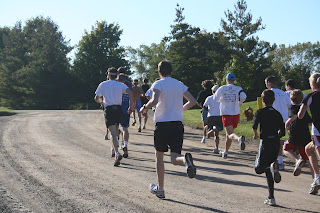 A strange thing happened to me this past Saturday. My alarm oh so pleasantly woke me up bright and early so I could get ready for my long run. Then (and this has never happened before), I just decided NOT to run. Not only that, I didn't feel bad about it! For someone who has used running over the years as a stress reliever, passion and way to stay healthy and fit, NOT running was never in my repertoire. I needed to run. However, on Saturday, and a few days past, another realization came to mind-sometimes it is okay, and even beneficial, to skip that run for a few days.
A strange thing happened to me this past Saturday. My alarm oh so pleasantly woke me up bright and early so I could get ready for my long run. Then (and this has never happened before), I just decided NOT to run. Not only that, I didn't feel bad about it! For someone who has used running over the years as a stress reliever, passion and way to stay healthy and fit, NOT running was never in my repertoire. I needed to run. However, on Saturday, and a few days past, another realization came to mind-sometimes it is okay, and even beneficial, to skip that run for a few days.Running has been a great part of my life, but I can also safely say at points it has been an obsession. The only times I took time off were for the many and prevalent injuries I sustained from overtraining. When I didn't run, I felt listless, stressed, and unbalanced. My "runner's high" kept me sane. It also kept me from finding other healthy, balanced ways to regulate my stress and health. The all-or-nothing philosophy worked really well with running-until I got injured, of course.
In training for my next marathon, I've been battling extreme heat, a varying schedule, and a new addition into our household (our lovely German Shepherd, Juneau). Through the busyness, fatigue, and stress, I continued to fit in running. But I also began to feel the beginnings of burn-out: Irritability, constant fatigue and muscle soreness. In the past, I would continue to run through until my body couldn't take it and something broke down. This time, I just decided to take a few days off. I don't even have a specific day to come back (although I'm still in training for a marathon, so it can't be too long!). I do know that I want to look forward to my runs, and the break will be as long as that may take.
There's still a small pang of guilt for missing a few runs. But what are a few runs in the bigger scheme of a lifetime of health?
So I'll see you on the next run...or not. We'll see.
(This is a past post from 2011-I'm not training for a marathon right now!)





